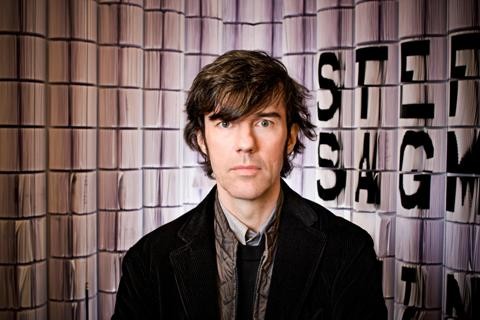 Stefan Sagmeister is a graphic designer who has literally suffered for his art.
Stefan Sagmeister is a graphic designer who has literally suffered for his art.
He achieved notoriety in the 1990s as a designer who self-harmed in the name of his craft and will this year launch a film exploring happiness, where he asks if we can train our minds to be happy in the way we train our bodies to be fit and healthy.
Sagmeister will appear at this year’s designEX as part of a series curated by The Office of Good design titled 7 Kinds of Happiness: Conversations on Design and Emotion a series of physical and digital conversations.
Architecture & Design (A&D) spoke to him about what makes him happy, why he self-harmed for art and how to create happiness in design.
How do you think designers create happiness?
Some of the things designers create can either delight people or it can help people. None of these products and services will create permanent happiness, but a number have the chance to have a positive impact either on short term (joy) or medium term (satisfaction) happiness.
Can you give me an example of where a design has created a strong, positive emotion in yourself?
There was an early situation that I have repeated recently and found it still works: take the design object ‘motorcycle’, add the design object ‘MP3 player’, find a gorgeous, not too busy road and drive it without any purpose, just for the sake of driving. I experienced a true moment of bliss — complete with shivers running down my spine every time.
How can happiness be created in public projects, given happiness means different things to different people?
While this is of course true — happiness means different things to different people — there are still public projects that work better for more people and increase their well-being.
One of my favorite examples would be Peter Zumthor's public spa in Vals, Switzerland. It is a stark, minimalist example of high-end architecture placed for maximum contrast into one of the most rugged parts of the Swiss Alps that works for a public that has no interest in design. My 80 year-old mum loved it and 10 year-old boys talk quietly and walk calmly, not because a sign tells them, but because they do feel that the space demands it.
What makes you happy?
In design, I have a whole list:
- thinking about ideas and content freely — with the deadline far away
- traveling to new places
- using a wide variety of tools and techniques
- working on projects that matter to me
- having things come back from the printer done well
- getting feedback from people who see our work
- designing a project that feels partly brand new and partly familiar
- working without interruption on a single project
What makes you unhappy?
- A long commute
- Persistent noise
- Having to do things over again, when better organisation could have avoided it
Your bio says a sense of humour surfaces in your designs. How does a sense of humour come out in your designs?
Every joke contains at its very heart a surprise — no punch line would ever work without it. And of course, if you have to communicate a message in a short period of time, surprise and humour would have to play a role.
You created a poster advertising a speaking engagement by carving the details onto your torso. What sparked that idea and how did it feel when you were doing it?
The reasons were many. For the lecture poster for the AIGA Detroit we tried to visualise the pain that seemed to accompany a number of our design projects. It neatly visualised the process of its making, and process was the buzz word within the graphics world at the time. It visually said that we'd do anything for design. Our intern Martin cut all the type into my skin. Yes, it did hurt — real bad.
What is the best piece of advice anyone has ever given you, either personally or professionally?
It came from Tibor Kalman, when I opened my own studio: "The most difficult thing when running a design studio is to figure out how not to grow. Everything else is easy".

